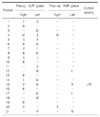Abstract
Subureteral injection of bulking agents is an accepted, less invasive, treatment of vesicoureteral reflux (VUR) in children. We evaluated the efficacy of an endoscopic subureteral polydimethylsiloxane (Macroplastique®) injection with primary VUR in children. A total of 21patients (31 renal units), aged between 2 and 15 years were included in this study. The vesicoureteral reflux was grade I in 5, grade II in 7, grade III in 9, grade IV in 7 and grade V in 3 renal units. PDS was injected submucosally under the ureteric orifice, converting the opening to allow the elevation of the mucosa, so that the orifices lay on the summit of a small mound, which assumed an elevated crescent appearance by the end of the procedure. The patients were followed up from 6 to 24 months (mean 18.5 months) with voiding cystourethrography. Overall, the reflux was corrected in 26 of the renal units (83.8%) in one injection. The correction rates, according to the reflux grade, were 100, 100, 88.8, 71.4, 66.7% for grades I to V, respectively. There were no associated postoperative complications. The mean hospital stay and operation time were 2.7 days (2~4 days) and 17.5 minutes (12~25 minutes), respectively. In conclusion, for low grade reflux, subureteral PDS injection therapy could be a primary treatment for VUR in children because it is simple, less invasive, decreased hospital stay and showes a high success rate.
Figures and Tables
Fig. 1
Cystoscopic finding and ultrasonographic finding after subureteral injection therapy. (A) Ureteral oriffice after injection which shows inverted crescent shaped ureteral orifice at summit of mound. (B) Postoperative ultrasonography shows an echogenic nodule of injected polydimethylsiloxane (PDS).

References
1. Dodat H, Valmalle AF, Weidmann JD, Collet F, Pelizzo G, Dubois R. Endoscopic treatment of vesicorenal reflux in children. Five-year assessment of the use of macroplastique. Prog Urol. 1998. 8:1001–1006.
2. Herz D, Hafez A, Bagli D, Capolicchio G, McLorie G, Khoury A. Efficacy of endoscopic subureteral polydimethylsiloxane injection for treatment of vesicoureteral reflux in children: a north American clinical report. J Urol. 2001. 166:1880–1886.

3. Park JW, Kim KS. An experience of endoscopic polydimethylsiloxane injection for the treatment of vesicoureteral reflux in children. Korean J Urol. 2003. 44:150–154.
4. Sung HH, Park HJ, Park KH. Experience of subureteral polydimethylsiloxane injection treatment in children with vesicoureteral reflux. Korean J Urol. 2007. 48:82–86.

5. Solomon LZ, Birch BR, Cooper AJ, Davies CL, Holmes SAV. Nonhomologous bioinjectable materials in urology: 'size matters'? BJU Int. 2000. 85:641–645.

6. Lebowitz RL, Olbing H, Parkkulainen KV, Smellie JM, Tamminen-Möbius TE. Internatinal system of radiolgraphic grading of vesicoureteral reflux. International reflux study in children. Pediatr Radiol. 1985. 15:105–109.

7. Matouschek E. Treatment of vesicorenal reflux by transurethral tefloninjection (author's transl). Urologe A. 1981. 20:263–264.
8. Puri P, O'Donnell B. Correction of experimentally produced vesicoureteric reflux in the piglet by intravesical injection of Teflon. Br Med J (Clin Res Ed). 1984. 289:5–7.

9. O'Donnell B, Puri P. Treatment of vesicoureteric reflux by endoscopic injection of Teflon. Br Med J (Clin Res Ed). 1984. 289:7–9.
10. Joyner BD, Atala A. Endoscopic substances for the treatment of vesicoureteral reflux. Urology. 1997. 50:489–494.

11. Bhatti HA, Khattak H, Boston VE. Efficacy and causes of failure of endoscopic subureteric injection of Teflon in the treatment of primary vesicoureteric reflux. Br J Urol. 1993. 71:221–225.

12. Smith DP, Kaplan WE, Oyasu R. Evaluation of polydimethylsiloxane as an alternative in the endoscopic treatment of vesicoureteral reflux. J Urol. 1994. 152:1221–1224.

13. Cukier J, Beauchamp RA, Spindler JS, Spindler S, Lorenzo C, Trentham DE. Association between bovine collagen dermal implants and a dermatomyositis or a polymyositis-like syndrome. Ann Intern Med. 1993. 118:920–928.

14. Oswald J, Riccabona M, Lusuardi L, Bartsch G, Radmayr C. Prospective comparison and 1-year follow-up of a single endoscopic subureteral polydimethylsiloxane versus dextranomer/hyaluronic acid copolymer injection for treatment of vesicoureteral reflux in children. Urology. 2002. 60:894–897.

15. Park JW, Kim KS. An experience of endoscopic polydimethylsiloxane injection for the treatment of vesicoureteral reflux in children. Korean J Urol. 2003. 44:150–154.
16. Ozyavuz R, Ozgur GK, Yuzuncu AK. Subureteric polydimethylsiloxane injection in the treatment of vesico-ureteric reflux. Int Urol Nephrol. 1998. 30:123–126.

17. Herz D, Hafez A, Bagli D, Capolicchio G, McLorie G, Khoury A. Efficacy of endoscopic subureteral polydimethylsiloxane injection for treatment of vesicoureteral reflux in children: a North American clinical report. J Urol. 2001. 166:1880–1886.

18. van Capelle JW, de Haan T, El Sayed W, Azmy A. The long-term outcome of the endoscopic subureteric implantation of polydimethylsiloxane for treating vesico-ureteric reflux in children: a retrospective analysis of the first 195 consecutive patients in two European centres. BJU Int. 2004. 94:1348–1351.

19. Ortenberg J. Endoscopic treatment of vesicoureteral reflux in children. Urol Clin North Am. 1998. 25:151–156.

20. Leonard MP, Decter A, Mix LW, Johnson HW, Coleman GU. Endoscopic treatment of vesicoureteral reflux with collagen: preliminary report and cost analysis. J Urol. 1996. 155:1716–1720.

21. Gillenwater JY, Grayhack JT, Howards SS, Mitchell ME. Adult and pediatric urology. 2002. 4th ed. Philadelphia: Lippincott Williams & Wilkins;2423–2425. 2725–2728. .




 PDF
PDF ePub
ePub Citation
Citation Print
Print






 XML Download
XML Download